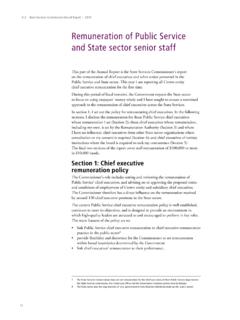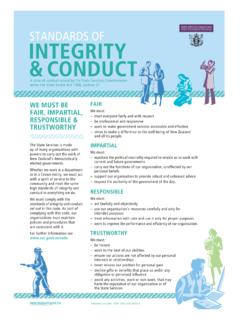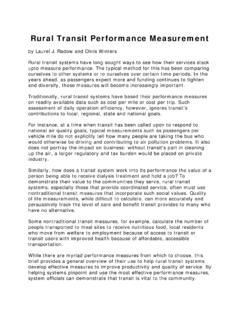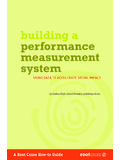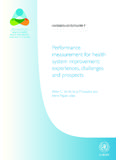Transcription of Performance Measurement cover - State Services …
1 Performance MeasurementAdvice and examples on how to develop effective frameworksDeveloped by the State Services Commission and The TreasuryAcknowledgementSSC and The Treasury wish to thank the many individuals and agencies who have contributed their knowledge and expertise to the development of this document. Thank you also to the Offi ce of the Auditor-General. OAG was consulted in the drafting of this document and acted as peer Services CommissionPO Box 329 WellingtonNew ZealandPh: (04) 495 6600 Fax: (04) 495 6686 The TreasuryPO Box 3726 WellingtonNew ZealandPh: (04) 472 2733 Fax: (04) 473 0982 Published August 2008 ISBN 978-0-478-30345-2 Crown copyright reserved 20081 Performance Measurement August 2008 Table of ContentsExecutive Summary .. 3 Introduction .. 7 Why this guide? .. 7 Performance reporting requirements .. 8 What this guide focuses on .. 8 When to use this guide .. 9 How this guide is structured.
2 9 Module 1 Why measure Performance ? .. 11 Overview .. 11 Performance Measurement as an iterative process .. 11 The three major goals of Performance 12 The three levels of Performance Measurement .. 12 Showing progress and results .. 14 The building block approach .. 15 Developing a Performance Measurement process .. 16 Module 2 Building an initial Performance picture .. 19 Overview .. 19 The step-by-step approach .. 20 Charting progress over time .. 20 Mapping major results back to resources .. 21 Module 3 Engaging with stakeholders over Measurement .. 23 Overview .. 23 Why develop an engagement plan? .. 23 Undertaking stakeholder analysis: the key steps .. 24 Analysing stakeholder relationships .. 26 Module 4 Defining outcomes, intermediate outcomes and outputs .. 31 Overview .. 31 Defining outcomes .. 31 Defining intermediate outcomes .. 32 Defining outputs .. 33 Definition tips .. 34 Tools for defining outcomes and intermediate outcomes.
3 35 Examples of good practice .. 36 Module 5 Developing measures and indicators .. 41 Overview .. 41 Developing robust measures .. 41 Examples of Performance measures .. 452 Performance Measurement August 2008 Module 6 Linking the three levels and linking results back to resources .. 55 Overview .. 55 Exploring the linkages .. 55 Embedding results to inform decision-making .. 57 Appendices .. 61 Appendix 1: Checklist for Performance measuring .. 61 Appendix 2: Further reading on Performance Measurement .. 62 Appendix 3: Glossary of terms .. 64 Figures and TablesFigure 1: The Performance Measurement cycle .. 11 Figure 2: The three levels of Measurement .. 12 Figure 3: Linking the levels of Measurement to planning and deliver .. 14 Figure 4: MAF s Performance Measurement roadmap .. 17 Figure 5: Linking MAF s objectives with its expected outcomes .. 18 Figure 6: The power-interest relationship with stakeholders.
4 24 Figure 7: The stakeholder analysis process .. 25 Figure 8: Example of power-interest relationships .. 26 Figure 9: Power-mandate-urgency relationship with stakeholders .. 27 Figure 10: New Zealand Defence Forces articulation of an intermediate outcome .. 39 Figure 11: Department of Labour s Performance for the Workforce Group .. 46 Figure 12: NZDF s balanced scorecard link between personnel and output delivery .. 48 Figure 13: NZDF total personnel numbers .. 49 Figure 14: Composition NZDF of workforce .. 50 Figure 15: NZDF attrition of personnel .. 50 Figure 16: Tracking staff numbers and associated costs .. 51 Figure 17: Main funding flows in the ABC sector from 2001/02 to 08/09 .. 52 Figure 18: Performance indicators for all schools .. 56 Figure 19: Apparent rates of retention from year 10 to year 12, full time secondary students, all schools ..57 Table 1: Outputs, intermediate outcomes, outcomes, results and relevant indicators.
5 15 Table 2: Common measures .. 21 Table 3: Characteristics of stakeholders .. 28 Table 4: Testing a measure using the FABRIC principles .. 42 Table 5: Examples of Performance measures by data type .. 44 Table 6: Measures of impact in the transport sector .. 53 Table 7: Public housing - proportion of new allocations to those in greatest need, 2005-06 .. 54 CONTENTS3 Performance Measurement August 2008 Executive SummaryWhy measure Performance ?To track and improve your agency s progress towards the outcomes it seeks to achieve for New Measurement is essential for effective managementAny agency with a policy, delivery, monitoring or sector oversight role needs a robust Performance Measurement framework to know whether its activities are effective and efficient. By measuring the Performance of your agency or sector, you can: understand how the outputs you are delivering are contributing to the achievement of the right outcomes for New Zealanders chart the progress you are making, to make adjustments when they are needed and to report on progress track the effectiveness of initiatives and programmes over time make informed decisions on what service delivery, policy priorities, capability investments and resource allocations to focus on.
6 The thing to remember: to think Performance Measurement , think impact!To select and prioritise the outputs that have the greatest impact towards desired outcomes, your agency needs to evaluate what impact its activities are having. An agency uses its resources to provide Services or undertakes activities its outputs with the objective of delivering specific outcomes for New Zealanders. To assess whether your agency s outputs are contributing to the achievement of desired outcomes, you need to measure the difference that your agency is making the impact of its interventions. Linking outputs, impacts and outcomesWhat are our goals for New Zealanders?OutcomesWhat difference are we making?ImpactsWhat activities are we undertaking?OutputsHow are we using our resources?ResourcesLess deaths on the roadReduced speedReduced drink-drivingIncreased use of safety beltsEngineeringEnforcementEducationWork forceFundingAssetsPlanningDeliveryEXECUT IVE SUMMARY4 Performance Measurement August 2008 EXECUTIVE SUMMARYHere is some good practice advice on Performance measurementTo assist managers, planners and analysts in State sector agencies develop robust Performance Measurement and reporting frameworks, Central Agencies have prepared this new resource: Performance Measurement : Advice and examples on how to develop effective frameworks.
7 The guide focuses on how to make Performance Measurement output, impact and outcome-orientated, so that results are easily understood and visible to senior managers and other stakeholders. The guide explains the key steps in the Performance Measurement cycle; why each step is important; and what activities are undertaken under each of the steps. The Performance Measurement cycleHow the guide is organised and what it coversThe guide has six modules. Each module covers a key element of the Performance Measurement cycle. How far your agency needs to delve into each module will depend on how advanced your current Performance Measurement systems are. Why measure Performance explains the importance and value of Performance Measurement to the State sector. It helps to define what results matter most and to scope out a Performance measuring framework. Building an initial Performance picture explores how to look critically at existing Measurement frameworks, identify gaps in Performance information and make improvements.
8 Engaging with stakeholders over Measurement looks at developing a stakeholder engagement plan to ensure that it delivers the information needed by internal and external stakeholders. Manage expectationsBuild Performance pictureBuild stakeholderpictureBuild Performance storyDefine outcomesLink levels of performanceGather data & develop metricsDefine impactsDefine outputsDevelop Policy & StrategyAlign CapabilitiesReport AchievementsImprove ResultsIMPROVED PERFORMANCE5 Performance Measurement August 2008 EXECUTIVE SUMMARY Defining outcomes, intermediate outcomes and outputs provides guidance on how to define the three levels of the framework well, and what good measures will look like. Developing measures and indicators covers how to choose your measures, and how to ensure appropriate data is collected in order to chart and report progress. It also provides useful examples from different sectors.
9 Linking the levels and linking results back to resources discusses how the Performance story can be drawn together to build confidence that delivery is efficient and effective, and that it is helping managers to make good decisions. Measuring progress and informing decision-makingHere is an example of how Performance Measurement helps agencies track the progress they are making towards the achievement of their outcomes, and how it can inform decision-making. The table below shows various indicators relevant to the land transport sector, and compares them to the investment in safety funding in that sector. The indicators show that increased safety funding in the sector has had a number of positive impacts for New Zealanders. Road safety Performance measuresFatal crashes Down 20-22%Hospital bed-days Down >22%Safety-related tickets Up 11-400%Cars exceeding 110 km/h Down 14%Speed-related fatal crashes Down 14%Rear seat belts worn Up 23%Fatalities avoidable by belt Down 22%Breath tests administered Up 23%Drunk driving offences Down 14%Safety funding for enforcement and education Up 27%Source: Taylor, Duigan, Barry Ltd and Parker Duigan Ltd, Initial Evaluation ( Stocktake ) of Road Safety to 2010 Strategy, November Measurement August 2008 Effective Performance Measurement : key points to rememberIf you are charged with developing and implementing a Performance Measurement framework for your agency or sector, here is a checklist of the key aspects to consider: Define a clear process within your agency to undertake Performance Measurement .
10 Set appropriate expectations about what the Performance Measurement process can achieve with the time and resources you have available. Achieving outcomes often requires effort from a number of agencies. Consult and engage with your stakeholders to define your shared outcomes. Continue to engage with your stakeholders throughout the process. Define your outcomes and impacts as specifically as possible so that they can be measured against; don t just make visionary statements; describe what you actually want to achieve. Define appropriate measures and indicators that will show progress. Link the Measurement process into the wider management processes of your agency, so that measures inform leaders decisions about planning, capability and resource SUMMARY7 Performance Measurement August 2008 INTRODUCTIONI ntroductionWhy this guide? Performance Measurement is a precursor to effective and informed management.



